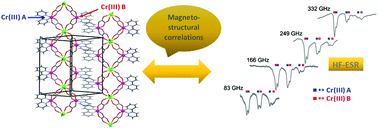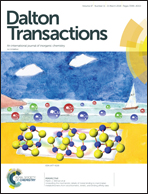Magneto-structural correlations in oxalate-bridged Sr(ii)Cr(iii) coordination polymers: structure, magnetization, X-band, and high-field ESR studies†
Abstract
The results of high-field electron spin resonance (HF-ESR) spectroscopy on the title 1D coordination polymers at frequencies up to 415 GHz, supported by X-ray diffraction, thermal, magnetic susceptibility, and X-band (10 GHz) ESR studies, are presented. The heterometallic compounds {SrCr2(phen)2(C2O4)4}·H2O (SrCrPhen) and {SrCr2(bpy)2(C2O4)4(H2O)}·5H2O (SrCrBpy) (phen = 1,10-phenanthroline, bpy = 2,2′-bipyridine) were synthesized. Structural analysis revealed double oxalate-bridged zigzag Sr–Cr chains while magnetic susceptibility studies showed paramagnetic behaviour of the complexes. HF-ESR spectroscopy data were analysed with a relevant spin-Hamiltonian, yielding the g, D and E parameters of the Cr(III) ions. Both complexes showed small magnetic easy-axis type anisotropy with |D| ∼ 1 K; SrCrBpy has uniaxial anisotropy while SrCrPhen has biaxial anisotropy. HF-ESR studies have enabled us to establish rational magneto-structural correlations and revealed significant differences between very similar crystal structures. Additionally, the ability of SrCrPhen and SrCrBpy to be single-source precursors for the formation of Sr–Cr oxides was investigated.



 Please wait while we load your content...
Please wait while we load your content...